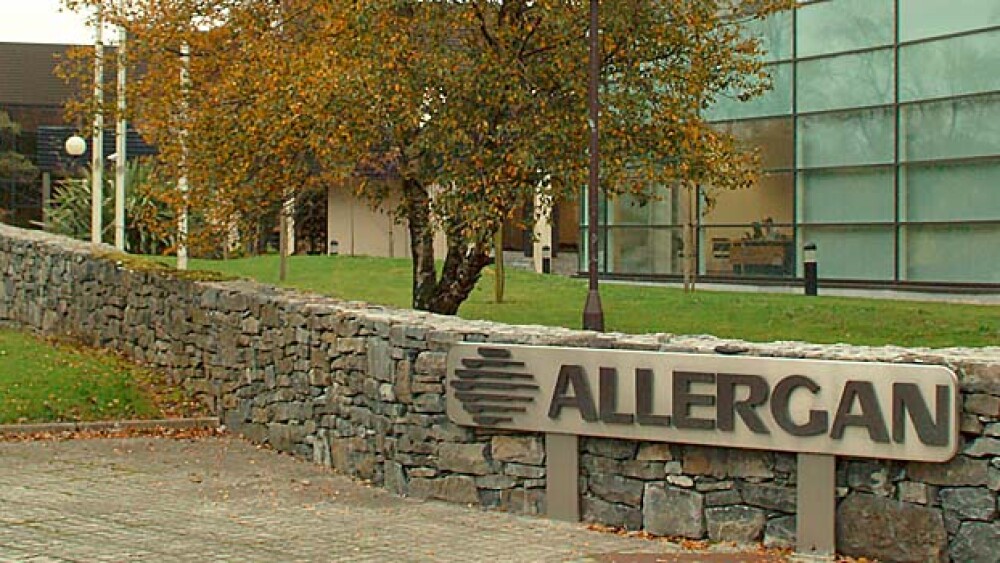Allergan Chief Executive Officer Brent Saunders delivered a rosy review of the first quarter for 2018, including a 3 percent growth in revenue to $3.67 billion over the past three months. However, investors are not terribly pleased and shares have fallen nearly 4 percent this morning.
Allergan Chief Executive Officer Brent Saunders delivered a rosy review of the first quarter for 2018, including a 3 percent growth in revenue to $3.67 billion over the past three months. However, investors are not terribly pleased and shares have fallen nearly 4 percent this morning.
Part of that concern among investors appears to be Saunders lack of interest in instituting any fundamental changes to the company’s business strategy. Some changes could include the sale of assets, M&A activity or splitting the company. Some of Allergan’s key investors are displeased that the stock has declined some 33 percent over the past 12 months and are want to see changes. Last week BioSpace reported that some of Allergan’s biggest shareholders have banded together to talk with potential activist investors who could spur change. These investors are keen on the company focusing on its key drivers including Botox and the dry eye treatment Restasis. They also see some business units, such as Allergan’s women’s health unit, as a potential asset to be sold off.
Despite the desires of those investors, Saunders said there are a few options the company can take. During a conference call with investors, analysts and reporters, Saunders said those options include a buyback of shares, divesting assets, splitting the company, M&A activity to spur revenue or continuing as it. Following the call, Reuters reported that Saunders considers running the company as is
the baseline against which all options need to be considered.” He noted that large transformational M*A deals are a low priority for the company.
“We’re not going to execute an activity that doesn’t recognize the full inherent value of our assets at Allergan,” Saunders said, according to Reuters.
In an announcement this morning Saunders pointed to the company’s success during the quarter. He said Allergan drove strong cash flow, continued to pay down and completed a $2 billion share repurchase program.
And to back up his vision, Saunders announced several positive moves the company has made this quarter, including strong growth in key branded products, such as Botox, Vraylar and birth control pill Lo Loestrin Fe.
Botox, which is used cosmetically as well as a therapeutic for migraine headaches, saw an increase in sales of 7 percent and 16 percent respectively to deliver $817.3 million during the quarter. Bipolar disorder treatment Vraylar saw significant growth over the quarter. Net revenues grew 57.5 percent in the first quarter to $84.4 million. Allergan said that was primarily due to increased promotional effort. Lo Loestrin Fe net revenues in the first quarter of 2018 were $114.6 million, an increase of 14.8 percent versus the prior-year quarter.
Unlike the continued growth of revenue from Botox, sales of blockbuster Restasis dropped significantly during the quarter. Restasis brought in $255.8 million, a decrease of 17.2 percent when compared to the same quarter in 2017. Demand growth of four percent was offset by trade buying patterns and lower net selling prices, Allergan said.
Allergan also announced several key clinical milestones, particularly with Cariprazine for Bipolar I Depression and Ubrogepant for Acute Migraine.
“Our team has continued to drive development of the R&D pipeline and we have achieved several key milestones, including delivering two positive pivotal phase III studies for Ubrogepant in acute migraine and the third positive pivotal study for Vraylar in bipolar depression. This is just the beginning of the clinical data read-outs and pipeline accomplishments we expect to achieve this year,” Saunders said in a statement.
But, while Saunders noted some pipeline positives, there were a few hiccups. In February the U.S. Food and Drug Administration pushed back the PDUFA data for Esmya, a treatment for abnormal uterine bleeding in women with uterine fibroids. The FDA extended the review date to August of 2018 to allow “time for a full review of the file.” The FDA had initially provided a PDUFA date of May to Allergan. The move coincides with a liver safety review being conducted by European regulators.
During the first quarter, Allergan also nixed a Phase II developmental RORyT ((retinoic acid receptor-related orphan receptor gamma) inhibitor program for psoriasis and other autoimmune disorders. Allergan acquired the program in 2016 when it bought Pennsylvania-based Vitae Pharmaceuticals for $639 million. In its quarterly filing Allergan said it recorded charges of $535.1 “primarily due to an impairment of the Company’s RORyT IP-R&D project for its Psoriasis indication.”





